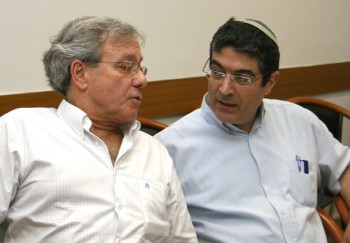| | 12 February, 2007
| | Israeli researchers cite east-west split with dire consequences for ancient Jewry | | Refute accepted thesis of a ‘unified’ Diaspora |
 | | Prof. Doron Mendels (left) and Dr. Arye Edrei |
|
The Jewish world separated into two basic spheres following the destruction of the Second Temple by the Romans in 70 AD, due primarily to a language gap and a geographical divide, say two Israeli scholars in an article that has just been published.
The schism that arose between eastern and western Jewries of that period, the authors say, provided a fertile ground for the early Christian preachings of Paul and the Apostles among the Jews of the west.
In presenting their argument, the authors, Prof. Doron Mendels of the Hebrew University of Jerusalem Department of History and Dr. Arye Edrei of the Tel Aviv University Faculty of Law, take issue with the accepted scholarly view that there was a basic, ongoing connection between the scattered Jews of that era. Mendels’ and Edrei’s thesis, which is based on research done while they were fellows of the Hebrew University’s Institute for Advanced Studies, is presented in an article just published in the Journal for the Study of the Pseudepigrapha,
Eastern Jewry, say Mendels and Edrei, incorporated the land of Israel, Babylonia, and other adjacent areas reaching up the Mediterranean coastline into Syria and down into eastern Egypt. Western Jewry included Asia Minor, Greece, Italy and the Mediterranean islands.
In the east, write Mendels and Edrei, the period after the Temple’s destruction was the time in which the oral law was developed, which much later was written down and codified into the Rabbinic literature of the Talmud. These writings form the basis of what became Halachic, or normative, Judaism. The languages of this oral and written tradition were Hebrew and Aramaic, the languages known to the Jews of the east.
Since this tradition was not translated, continue the authors, the oral tradition remained unknown to the Jews of the west, who spoke only Greek. For them, Jewish tradition was conveyed solely through the Bible via the Septuagint, the Greek translation of the Bible. The result was that the Jews of the west remained largely ignorant of the vast lore of Halacha. This dichotomy ultimately provided a fertile ground for the early emissaries of the Church, who created a communication network in the west that was lacking in Jewish society.
The Jewish literature that did develop in the west was what became known as the Apocrypha and the Pseudepigrapha, works of dubious origin that were not considered by the rabbis to be of sufficient divine inspiration or influence for inclusion in the Biblical canon.
While acknowledging the evidence that there were visits by rabbis of the post-Temple period to scattered communities, these communities were almost entirely within the land of Israel or Babylonia or adjacent areas, but hardly beyond that, say the authors. There were some rabbinic leaders who traveled to Rome, but their contacts there were mainly of a political nature with the rulers of the time.
Mendels and Edrei cite numerous Jewish and non-Jewish scholarly references in amplifying their thesis of the “forsaking” of western Diaspora Jewry and therefore its isolation from the developing Rabbinic Judaism of the east. The authors refrain from dealing with the roots of this phenomenon or many of its implications, saying that they leave that for further examination by researchers. They do, however, conclude that a high price was paid for keeping the oral tradition (and later its redactive form) only in Hebrew and Aramaic, thereby losing in consequence a vast constituency that was not fluid in those languages.
|
Downloadable File: edreimendels.doc |
|


